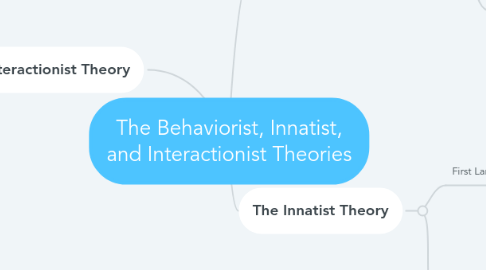
1. The Interactionist Theory
1.1. First Language Acquistion
1.1.1. Nature and Nurture involved in language acquisition
1.1.1.1. Adults scaffold conversations when they repeat what child means in grammatically correct language
1.1.2. Opposite of Innatist Theory
1.1.3. Caregivers and parents play vital role
1.1.3.1. Children want to communicate, caregivers motivate them to learn language in order to communicate with them
1.2. Second Language Acquistion
1.2.1. Communication between child and caregiver is critical
1.2.2. As understanding grows, interaction increases as child communicates more
1.2.3. Social environment is an important role; caregivers modify speech and carry conversations
2. The Behaviorist Theory
2.1. First Language Acquisition
2.1.1. Language learned through reinforcement
2.1.2. Imitation and Association are essential
2.2. Second Language Acquisition
2.2.1. Imitation, Practice and Selective Reinforcement in social environment
2.2.2. Major Factors are Parent Modeling and Reinforcement
3. The Innatist Theory
3.1. First Language Acquisition
3.1.1. Noam Chomsky proposed babies born with LAD
3.1.1.1. LAD- Language Acquisition Device
3.1.1.1.1. All languages use the same basic grammar, LAD allows babies to understand basic grammar in any language
3.1.1.2. "Pre-wired for Linguistic Analysis"
3.1.2. Language acquisition happens with little help from adults and caregivers
3.1.3. Critical Period from birth to about 9 years old
3.2. Second Language Acquisition
3.2.1. Uses child's syntax
3.2.2. Child uses LAD
3.2.2.1. Language used by others plays a minor role, simply triggers LAD response
